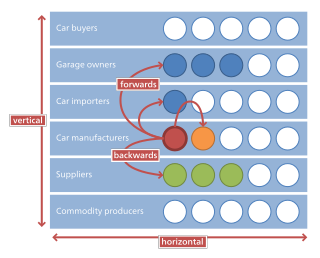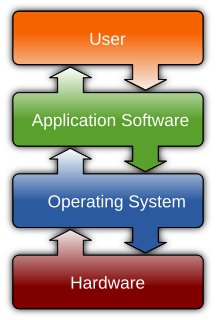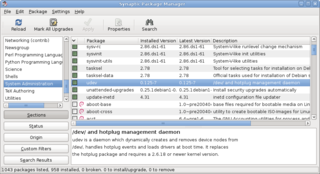In engineering and computing, "stovepipe system" is a pejorative term for a system that has the potential to share data or functionality with other systems but which does not do so. The term evokes the image of stovepipes rising above buildings, each functioning individually. A simple example of a stovepipe system is one that implements its own user IDs and passwords, instead of relying on a common user ID and password shared with other systems.

Engineering is the application of knowledge in the form of science, mathematics, and empirical evidence, to the innovation, design, construction, operation and maintenance of structures, machines, materials, devices, systems, processes, and organizations. The discipline of engineering encompasses a broad range of more specialized fields of engineering, each with a more specific emphasis on particular areas of applied mathematics, applied science, and types of application. See glossary of engineering.

Computing is any activity that uses computers. It includes developing hardware and software, and using computers to manage and process information, communicate and entertain. Computing is a critically important, integral component of modern industrial technology. Major computing disciplines include computer engineering, software engineering, computer science, information systems, and information technology.
A system is a group of interacting or interrelated entities that form a unified whole. A system is delineated by its spatial and temporal boundaries, surrounded and influenced by its environment, described by its structure and purpose and expressed in its functioning.
Stovepipes are
| “ | systems procured and developed to solve a specific problem, characterized by a limited focus and functionality, and containing data that cannot be easily shared with other systems. | ” |
A stovepipe system is generally considered an example of an anti-pattern, particularly found in legacy systems. This is due to the lack of code reuse, and resulting software brittleness due to potentially general functions only being used on limited input.
An anti-pattern is a common response to a recurring problem that is usually ineffective and risks being highly counterproductive. The term, coined in 1995 by Andrew Koenig, was inspired by a book, Design Patterns, which highlights a number of design patterns in software development that its authors considered to be highly reliable and effective.

In computing, a legacy system is an old method, technology, computer system, or application program, "of, relating to, or being a previous or outdated computer system," yet still in use. Often referencing a system as "legacy" means that it paved the way for the standards that would follow it. This can also imply that the system is out of date or in need of replacement.
Code reuse, also called software reuse, is the use of existing software, or software knowledge, to build new software, following the reusability principles.
However, in certain cases stovepipe systems are considered appropriate, due to benefits from vertical integration and avoiding dependency hell. [1] For example, the Microsoft Excel team has avoided dependencies and even maintained its own C compiler, which helped it to ship on time, have high-quality code, and generate small, cross-platform code. [1]

In microeconomics and management, vertical integration is an arrangement in which the supply chain of a company is owned by that company. Usually each member of the supply chain produces a different product or (market-specific) service, and the products combine to satisfy a common need. It is contrasted with horizontal integration, wherein a company produces several items which are related to one another. Vertical integration has also described management styles that bring large portions of the supply chain not only under a common ownership, but also into one corporation.
Dependency hell is a colloquial term for the frustration of some software users who have installed software packages which have dependencies on specific versions of other software packages.

Microsoft Excel is a spreadsheet developed by Microsoft for Windows, macOS, Android and iOS. It features calculation, graphing tools, pivot tables, and a macro programming language called Visual Basic for Applications. It has been a very widely applied spreadsheet for these platforms, especially since version 5 in 1993, and it has replaced Lotus 1-2-3 as the industry standard for spreadsheets. Excel forms part of Microsoft Office.



